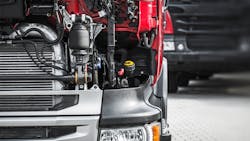Class 8 truck service items to watch after 500,000 miles
As the average lifecycle of commercial vehicle tractors has extended out to 8.7 years, according to the American Transportation Research Institute, truck suppliers have begun adapting their preventive maintenance and seeing more interest in an extra layer of protection and peace of mind.
“We are definitely seeing many more requests for information on extended warranties coming through our website these days,” said Melinda McAuliff, director of marketing for Kenworth Northeast, a multi-location dealership serving New York, Massachusetts and Rhode Island.
“As the age of vehicles in the field extends beyond historic levels, there is risk that they will experience incrementally higher failure rates, including potentially more catastrophic failures,” said Anthony Balkonis, vice president of services and warranty at Navistar. “Extended warranties eliminate spend risk and can provide predictable cash flows for the business, something that is important to both large and small fleets.”
To address the issue of longer wait times for new vehicles over the past couple of years, Navistar has introduced a warranty bridge program to provide extended coverage for older vehicles awaiting replacement. “The program has been strongly embraced by our customers and is providing them with improved cash flow, security, and predictability,” Balkonis said.
Read more: SKF Vehicle Aftermarket extends leading warranty
“In my opinion, if a fleet isn’t purchasing an extended warranty these days, they aren’t spending their money right,” added J. Ellis, director of service operations for Kenworth Northeast. “If you don’t have an extended warranty on the engine, but have a turbo failure, the turbo itself is $7,000. Then it’s probably going to take out the aftertreatment, too, which will cost another $10,000 or so.”
Ellis said a base vehicle extended warranty is a great investment because it covers essentially everything that might go wrong later in the truck’s life.
In the meantime, shops can do everything in their power to prevent these later-life issues before they start. Here’s a quick hit list of key service items a fleet will want to start looking at once a truck-tractor cruises past the 500,000-mile threshold.
- Inspect rubber seals on aftertreatment system composite connectors for water and corrosion intrusion
- Consider proactively replacing the DOC if the frequency of active regens increases dramatically
- Replace transmission fluid and filter per OEM recommendation
- Perform teardown inspection of rear axle wheel ends, paying close attention to bearing wear pattern and replacing wheel seals
- Replace oil on steer and rear axles
- Change power steering fluid and filter, paying close attention for signs of metal in the filter pleats which would necessitate further inspection
- Flush, drain, and refill extended-life coolant
- Inspect wiring harnesses and harness connectors for chafing
- Inspect drum brake cams and bushings for wear or damage. Look for signs of oil, transmission fluid, and coolant leaks
- Consider proactively replacing O-rings and seals in the lubrication system
- Consider starting an oil analysis program
- Inspect braking system hoses for cracks and damage, especially where plastic connectors are being used; simply replace when in doubt
- Inspect the entire air dryer and consider proactively replacing
- Consider replacing leaf springs, air bags, and rear suspension; first inspect mounting points and suspension spring components for cracks or missing spring stacks, inspect air bags for cracking rubber and chafing, and look for leaking airline connections and level valve binding
- Start planning for an engine rebuild around 750,000 miles or sooner if the vehicle has been operated in a harsh environment
- Inspect all clutch parts, paying attention to clutch free play and grab height to gauge lining wear
Editor’s Note: Always refer to your vehicle’s owner’s manual for specific maintenance interval recommendations based on age, hours, mileage, duty cycle, average idle time, fuel economy, etc.
About the Author

Gregg Wartgow
Gregg Wartgow is a freelancer who Fleet Maintenance has relied upon for many years, writing about virtually any trucking topic. He lives in Brodhead, Wisconsin.
